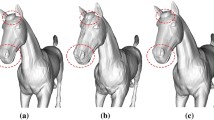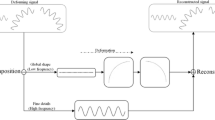Abstract
Compressing floating-point time-varying volume data and achieving both high compression rate and near lossless are challenging. This paper proposes a compression domain volume rendering (CDVR) approach based on hierarchical vector quantization (HVQ) and perfect spatial hashing (PSH) techniques. First, a HVQ process is applied to the first frame to obtain codebooks and index volumes. Then, a sparse residual volume (SRV) is computed by differencing the first frame and the recovery volume, which is reconstructed by utilizing the codebooks and the index volumes. Difference volumes are calculated by differencing the adjacent frame pairs of the time-series. Thereafter, both the SRV and the difference volumes are compressed by means of PSH technique. To render the time-series, the codebooks, the index volumes and the results of PSH are decompressed on-the-fly in constant time in GPU. In addition, a high compression rate is achieved by HVQ and PSH, and the compression is near lossless. The results on varied datasets verify that the proposed method can achieve the high compression rate and near lossless compression quality for floating-point time-varying volume data, as well as high efficient CDVR.
Graphical Abstract










Similar content being viewed by others
References
Balsa Rodréguez M, Gobbetti E, Iglesias Guitián J, Makhinya M, Marton F, Pajarola R, Suter S (2014) State-of-the-art in compressed gpu-based direct volume rendering. In: Computer Graphics Forum. Wiley Online Library
Fout N, Akiba H, Ma K-L, Lefohn AE, Kniss J (2005) High quality rendering of compressed volume data formats. In: Proceedings of the Seventh Joint Eurographics/IEEE VGTC conference on Visualization. Eurographics Association pp 77–84
Fout N, Ma K-L (2007) Transform coding for hardware-accelerated volume rendering. Vis Comput Graph, IEEE Trans 13(6):1600–1607
Fout N, Ma K-L (2012) An adaptive prediction-based approach to lossless compression of floating-point volume data. Vis Comput Graph, IEEE Trans 18(12):2295–2304
Gobbetti E, Iglesias Guitián JA, Marton F (2012) Covra: a compression-domain output-sensitive volume rendering architecture based on a sparse representation of voxel blocks. In: Computer Graphics Forum. Wiley Online Library, vol 31, pp 1315–1324
Jang Y, Ebert DS, Gaither K (2012) Time-varying data visualization using functional representations. Vis Comput Graph, IEEE Trans 18(3):421–433
Kraus M, Ertl T (2002) Adaptive texture maps. In: Proceedings of the ACM SIGGRAPH/EUROGRAPHICS conference on Graphics hardware. Eurographics Association, pp 7–15
Lefebvre S, Hoppe H (2006) Perfect spatial hashing. In: ACM Transactions on Graphics (TOG), vol 25. ACM pp 579–588
Linde Y, Buzo A, Gray RM (1980) An algorithm for vector quantizer design. Commun, IEEE Trans 28(1):84–95
Lindstrom P, Isenburg M (2006) Fast and efficient compression of floating-point data. Vis Comput Graph, IEEE Trans 12(5):1245–1250
Lu Z, Zheng W, Sun S (2011) Applications of vector quantization in multimedia signal processing. Science Press
Lum EB, Ma KL, Clyne J (2001) Texture hardware assisted rendering of time-varying volume data. In: Proceedings of the conference on Visualization’01. IEEE Computer Society, pp 263–270
Ma K-L (2003) Visualizing time-varying volume data. Comput Sci Eng 5(2):34–42
Ma K-L, Shen H-W (2000) Compression and accelerated rendering of time-varying volume data. In: Proceedings of the 2000 International Computer Symposium-Workshop on Computer graphics and virtual reality, pp 82–89
Ning P, Hesselink L (1992) Vector quantization for volume rendering. In Proceedings of the 1992 workshop on Volume visualization. ACM, pp 69–74
Ning P, Hesselink L (1993) Fast volume rendering of compressed data. In: Visualization, 1993. Visualization’93, Proceedings., IEEE Conference on. IEEE, pp 11–18
Parys R, Knittel G (2009) Giga-voxel rendering from compressed data on a display wall
Schneider J, Westermann R (2003) Compression domain volume rendering. In: Visualization, 2003. VIS 2003. IEEE. IEEE, pp 293–300
Shen H-W, Chiang L-J, Ma K-L (1999) A fast volume rendering algorithm for time-varying fields using a time-space partitioning (tsp) tree. In: Proceedings of the conference on Visualization’99: celebrating ten years. IEEE Computer Society Press pp 371–377
Shen H-W, Johnson CR (1994) Differential volume rendering: a fast volume visualization technique for flow animation. In: Proceedings of the conference on Visualization’94. IEEE Computer Society Press pp 180–187
Wang C, Yu H, Ma K-L (2010) Application-driven compression for visualizing large-scale time-varying data. Comput Graph Appl, IEEE 30(1):59–69
Ye S, Wang G, Chen H, Zhou M, Chen G, Chen W (2011) Gpu-friendly regularization and volume rendering of tetrahedral volumetric datasets. J Comput-Aided Design Comput Graph 23(6):933–940
Zhao L, Xiao D, Li K, Yue G, Peng C (2009) An efficient algorithm for large-scale volume data compression and its application in seismic data processing. J Comput-Aided Design Comput Graph 11:1606–1611
Zhou K, Ren Z, Lin S, Bao H, Guo B, Shum H-Y (2008) Real-time smoke rendering using compensated ray marching. In: ACM Transactions on Graphics (TOG), ACM vol 27, p 36
Acknowledgments
Supported by National High Technology Research and Development Program of China (2012AA12090), Major Program of National Natural Science Foundation of China (61232012), National Natural Science Foundation of China (81172124), National Natural Science Foundation of China (No. 61003193), National Natural Science Foundation of China (61303134), Zhejiang Provincial Natural Science Foundation of China(LY13F020048).
Author information
Authors and Affiliations
Corresponding author
Rights and permissions
About this article
Cite this article
Ding, Zy., Tan, Jg., Wu, Xy. et al. A near lossless compression domain volume rendering algorithm for floating-point time-varying volume data. J Vis 18, 147–157 (2015). https://doi.org/10.1007/s12650-014-0268-4
Received:
Revised:
Accepted:
Published:
Issue Date:
DOI: https://doi.org/10.1007/s12650-014-0268-4




